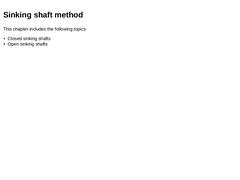
|
|
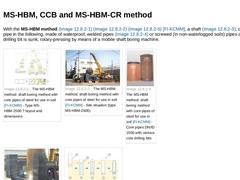
|
With the MS-HBM method (Bild 12.7.1) (Bild 12.7.1) (Bild 12.7.1) [FI-KCMM], a shaft (Bild 12.7.1), called a core pipe in the following, made of waterproof, welded pipes (Bild 12.7.1) or screwed (in non-waterlogged soils) pipes and core drilling bit is sunk, rotary-pressing by means of a mobile shaft boring machine. | (Image: The MS-HBM method: shaft boring method with core pipes of steel for use in soil [FI-KCMM] - Type MS-HBM-2500 ? layout and dimensions) |
|

|
The ART method (ART = All Round Tatekou) [FI-Sanwaa] corresponds in principle to the methods described on Abschnitt 12.7.1. The core piece of this shaft boring installation is a rotary table connected to a mobile hydraulic excavator (Bild 12.7.2) (Bild 12.7.2) which is positioned, anchored and aligned horizontally at the surface before beginning work [Kenic97]. | (Image: ART method [FI-Sanwaa] - Design of the rotary table) | (Image: ART method [FI-Sanwaa] - … |
|

|
|
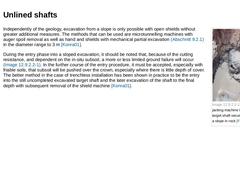
|
(Image: Entry of a jacking machine into an unlined target shaft secured by means of a slope in rock [FI-Herreb]) Independently of the geology, excavation from a slope is only possible with open shields without greater additional measures. The methods that can be used are microtunnelling machines with auger spoil removal as well as hand and shields with mechanical partial excavation (Abschnitt 9.2.1) in the diameter range to 3 m [Konra01]. During the … |
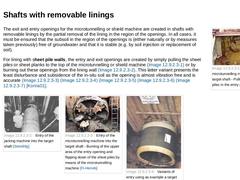
|
(Image: Entry of the microtunnelling machine into the target shaft - Pulling of the sheet piles in the entry area [Stein05a]) The exit and entry openings for the microtunnelling or shield machine are created in shafts with removable linings by the partial removal of the lining in the region of the openings. In all cases, it must be ensured that the subsoil in the region of the openings is (either naturally or by measures taken previously) free of … |
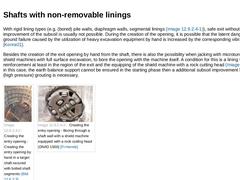
|
With rigid lining types (e.g. (bored) pile walls, diaphragm walls, segmental linings (Bild 12.8.1.3)), safe exit without additional improvement of the subsoil is usually not possible. During the creation of the opening, it is possible that the latent danger of existing ground failure caused by the utilization of heavy excavation equipment by hand is increased by the corresponding vibrations [Konra01]. Besides the creation of the exit opening by hand … |
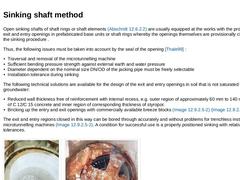
|
Open sinking shafts of shaft rings or shaft elements (Abschnitt 12.6.2.2) are usually equipped at the works with the project-specific exit and entry openings in prefabricated base units or shaft rings whereby the openings themselves are provisionally closed during the sinking procedure . Thus, the following issues must be taken into account by the seal of the opening [Thale99] : - Traversal and removal of the microtunnelling machine
- Sufficient bending …
|

|
|
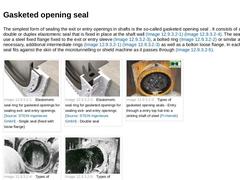
|
The simplest form of sealing the exit or entry openings in shafts is the so-called gasketed opening seal . It consists of a single or double or duplex elastomeric seal that is fixed in place at the shaft wall (Bild 12.8.2.1) (Bild 12.8.2.1). The seal fixture may use a steel fixed flange fixed to the exit or entry sleeve (Bild 12.8.2.1), a bolted ring (Bild 12.8.2.1) or similar and, if necessary, additional intermediate rings (Bild 12.8.2.1) (Bild … |
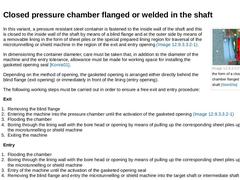
|
(Image: Exit lock in the form of a closed pressure chamber flanged to the starting shaft [Stein05a]) In this variant, a pressure resistant steel container is fastened to the inside wall of the shaft and this is closed to the inside wall of the shaft by means of a blind flange and at the outer side by means of a removable lining in the form of sheet piles or the special prepared lining region for traversal of the microtunnelling or shield machine in … |

|
A special solution for microtunnelling with nominal sizes of jacking pipes up to a maximum of DN/ID 800 is the closed pressure chamber (Bild 12.8.2.2.2) (Bild 12.8.2.2.2) (Bild 12.8.2.2.2) (Bild 12.8.2.2.2) (Bild 12.8.2.2.2) (Bild 12.8.2.2.2). This closed pressure chamber is integrated into the shaft face from open sinking shafts, which are made of prefabricated reinforced concrete shaft rings (Abschnitt 12.6.2.2) (Abschnitt 12.8.1.4), by the factory. |

|
(Image: Open pressure chamber welded to the inside of the shaft) Open pressure chambers welded into the shaft find particular application in sheet pile linings (Bild 12.8.2.2.3). The pressure chamber is sealed to the inside of the shaft by means of a steel box open welded to the sheet pile wall and open at the top. The top edge of the steel box must be above the maximum level of groundwater to be expected. The opening of the pressure chamber to the … |
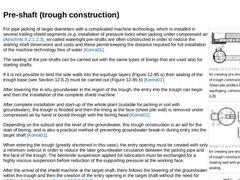
|
|
(Image: Possibilities for creating pre-shafts in the form of trough constructions [Konra01] - Sheet pile profiles binding into an aquifuging, cohesive soil strata (LB))
|
|
(Image: Possibilities for creating pre-shafts in the form of trough constructions [Konra01] - Sealing wall with jet grouting base sealing)
|
|
(Image: Entry procedure in a pre-shaft of sheet piles with binding into an aquifuging soil strata [Konra01])
|
For pipe jacking of larger … |
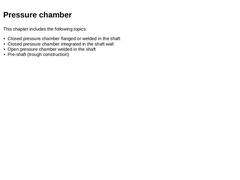
|
|
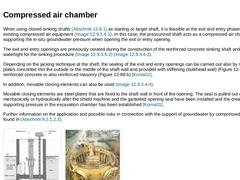
|
When using closed sinking shafts (Abschnitt 12.6.1) as starting or target shaft, it is feasible at the exit and entry phases to use the existing compressed air equipment (Bild 12.8.2.3). In this case, the pressurized shaft acts as a compressed air chamber for supporting the in-situ groundwater pressure when opening the exit or entry opening. The exit and entry openings are previously created during the construction of the reinforced concrete sinking … |
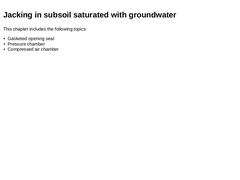
|
|

|
|
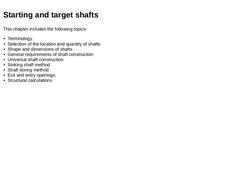
|
|
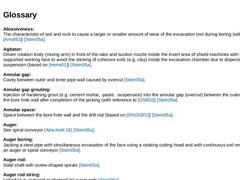
|
Abrasiveness:
The characteristic of soil and rock to cause a larger or smaller amount of wear of the excavation tool during boring (with reference to [Arnol93]) [Stein05a]. Agitator:
Driven rotation body (mixing arm) in front of the rake and suction nozzle inside the invert area of shield machines with fluid-supported working face to avoid the sticking of cohesive soils (e.g. clay) inside the excavation chamber due to dispersion of the suspension (… |
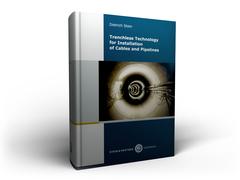
|
With trenchless pipeline construction methods, it is now possible to install cables and pipelines underground, irrespective of the outer diameter or nominal size and the geological and hydrogeological boundary conditions. The wide-ranging technical information in this standard reference book not only helps the user in the planning and execution of pipeline construction measures, but also provides a basis for an economically and technically optimal selection of the process technology. In detail, the technical book deals with the following topics: geotechnical fundamentals and investigations, unmanned, steerable and non-steerable methods (soil displacement methods, pilot pipe jacking, microtunneling, manned methods (pipe jacking), drilling fluids and drilling fluid technology, jacking control, surveying and monitoring, start and target shafts, calculation of jacking pipes, tendering and contract award information, and economic feasibility considerations. |
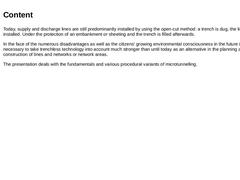
|
Today, supply and discharge lines are still predominantly installed by using the open-cut method: a trench is dug, the lines are installed. Under the protection of an embankment or sheeting and the trench is filled afterwards. In the face of the numerous disadvantages as well as the citizens' growing environmental consciousness in the future it is urgently necessary to take trenchless technology into account much stronger than until today as an alternative … |

|
|
(Image: Unmanned techniques) |
|
(Image: Steerable techniques) |
|
Microtunnelling:
Microtunnelling refers to unmanned, remote-controlled techniques for pipe jacking (jacking pipe ID < 1200 (48 in)) in which, for reasons of machine technology and occupational health and safety, the use of personnel on the working face during jacking is prohibited. This also applies during troubleshooting for example when the jacking is at a standstill. |
|
Microtunnelling |
|
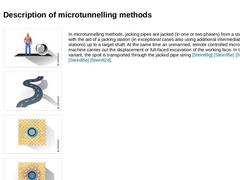
|
|
(Image: Unmanned techniques) |
|
(Image: Steerable techniques) |
|
(Image: Soil removal techniques) |
|
(Image: Soil displacement techniques) |
|
In microtunnelling methods, jacking pipes are jacked (in one or two phases) from a starting shaft with the aid of a jacking station (in exceptional cases also using additional intermediate jacking stations) up to a target shaft. At the same time an unmanned, remote controlled microtunnelling machine carries out … |
|
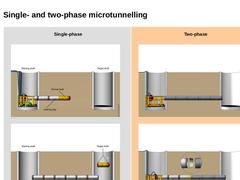
|
|
Single-phase |
(Image: Single-phase jacking - Jacking) |
|
(Image: Single-phase jacking - Completed pipeline) |
|
Two-phase |
(Image: Two-phase jacking - Phase 1) |
|
(Image: Two-phase pipe jacking - Phase 2) |
|
|